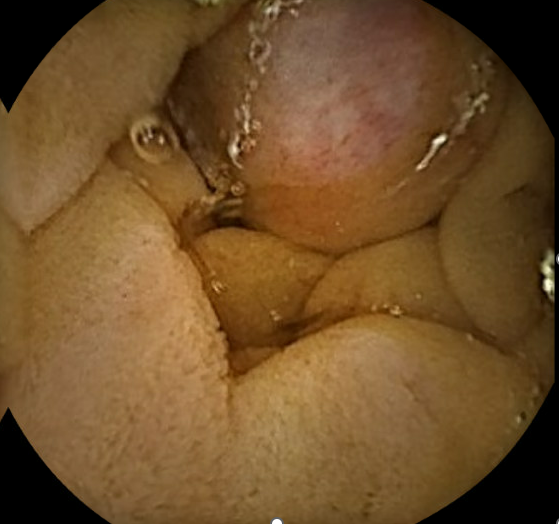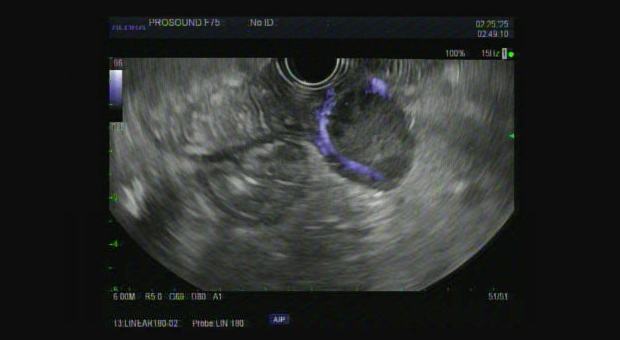Sunday Poster Session
Category: GI Bleeding
P1011 - A Duodenal Gastrointestinal Stromal Tumor Presenting as an Obscure GI Bleed
Sunday, October 26, 2025
3:30 PM - 7:00 PM PDT
Location: Exhibit Hall
- MH
Muneer Hasso, MD
Henry Ford Health
Detroit, MI
Presenting Author(s)
Muneer Hasso, MD, Mark Obri, MD, Duyen Dang, MD, Sumair Ahmad, MD
Henry Ford Health, Detroit, MI
Introduction: Gastrointestinal stromal tumors (GIST) are rare mesenchymal neoplasms of the gastrointestinal (GI) tract that compose approximately 1-2% of all gastrointestinal neoplasms. GIST present most commonly in the elderly population. They most commonly arise in the stomach (40-60%) but can arise throughout the GI tract, including the duodenum (5% of GIST). While many GIST are asymptomatic, presenting symptoms can include GI bleeds, abdominal pain, or palpable abdominal masses.
Case Description/
Methods: We present a case of a 66-year-old female with a history of type II diabetes, hypertension, prior GI bleed a few months prior with negative esophagogastroduodenoscopy (EGD) and colonoscopy who presented to the emergency department (ED) for mixed black and bloody stools with associated dizziness. She was afebrile and hemodynamically stable on presentation. Her initial hemoglobin was 10.6 g/dl that downtrended to 5.7 g/dl and 4 units of packed red blood cells were transfused. Initial computed tomography angiography (CTA) revealed no active GI bleed but demonstrated a 2.3 cm proximal small bowel mass. Push Enteroscopy and capsule endoscopy failed to identify a bleeding source but demonstrated a 2 cm duodenal mass. Hemoglobin stabilized and patient was discharged; outpatient EGD with endoscopic ultrasound (EUS) showed a 2.6 cm subendothelial, hyper-vascular lesion arising from the muscularis propria of the distal duodenum; biopsy showed c-kit and DOG1 positivity, consistent with GIST. Patient subsequently referred to medical and surgical oncology and is awaiting follow up.
Discussion: GISTs are a rare but clinically significant cause of GI bleeding. They are often asymptomatic at presentation, but up to 25% of small intestinal GISTs present with GI bleed. While most cases of GIST are localized, 10-20% of cases are metastasized at presentation, most commonly to the liver and omentum. Resection of localized tumors >2cm is the mainstay of treatment; metastatic or nonresectable GIST are treated with adjuvant imatinib, a tyrosine kinase inhibitor. Tumors can be monitored depending on size and location.
Our patient presented with a clinically significant GI bleed with no active source of bleed identified. Given the extensive workup, the source of bleeding can likely be attributed to vascular duodenal GIST. While there are data regarding excision of tumor based on size, more studies are required to look at whether excising actively bleeding tumors has an effect on patient morbidity or mortality.

Figure: The GIST as seen on capsule endoscopy

Figure: The GIST as seen on EUS
Disclosures:
Muneer Hasso indicated no relevant financial relationships.
Mark Obri indicated no relevant financial relationships.
Duyen Dang indicated no relevant financial relationships.
Sumair Ahmad indicated no relevant financial relationships.
Muneer Hasso, MD, Mark Obri, MD, Duyen Dang, MD, Sumair Ahmad, MD. P1011 - A Duodenal Gastrointestinal Stromal Tumor Presenting as an Obscure GI Bleed, ACG 2025 Annual Scientific Meeting Abstracts. Phoenix, AZ: American College of Gastroenterology.
Henry Ford Health, Detroit, MI
Introduction: Gastrointestinal stromal tumors (GIST) are rare mesenchymal neoplasms of the gastrointestinal (GI) tract that compose approximately 1-2% of all gastrointestinal neoplasms. GIST present most commonly in the elderly population. They most commonly arise in the stomach (40-60%) but can arise throughout the GI tract, including the duodenum (5% of GIST). While many GIST are asymptomatic, presenting symptoms can include GI bleeds, abdominal pain, or palpable abdominal masses.
Case Description/
Methods: We present a case of a 66-year-old female with a history of type II diabetes, hypertension, prior GI bleed a few months prior with negative esophagogastroduodenoscopy (EGD) and colonoscopy who presented to the emergency department (ED) for mixed black and bloody stools with associated dizziness. She was afebrile and hemodynamically stable on presentation. Her initial hemoglobin was 10.6 g/dl that downtrended to 5.7 g/dl and 4 units of packed red blood cells were transfused. Initial computed tomography angiography (CTA) revealed no active GI bleed but demonstrated a 2.3 cm proximal small bowel mass. Push Enteroscopy and capsule endoscopy failed to identify a bleeding source but demonstrated a 2 cm duodenal mass. Hemoglobin stabilized and patient was discharged; outpatient EGD with endoscopic ultrasound (EUS) showed a 2.6 cm subendothelial, hyper-vascular lesion arising from the muscularis propria of the distal duodenum; biopsy showed c-kit and DOG1 positivity, consistent with GIST. Patient subsequently referred to medical and surgical oncology and is awaiting follow up.
Discussion: GISTs are a rare but clinically significant cause of GI bleeding. They are often asymptomatic at presentation, but up to 25% of small intestinal GISTs present with GI bleed. While most cases of GIST are localized, 10-20% of cases are metastasized at presentation, most commonly to the liver and omentum. Resection of localized tumors >2cm is the mainstay of treatment; metastatic or nonresectable GIST are treated with adjuvant imatinib, a tyrosine kinase inhibitor. Tumors can be monitored depending on size and location.
Our patient presented with a clinically significant GI bleed with no active source of bleed identified. Given the extensive workup, the source of bleeding can likely be attributed to vascular duodenal GIST. While there are data regarding excision of tumor based on size, more studies are required to look at whether excising actively bleeding tumors has an effect on patient morbidity or mortality.

Figure: The GIST as seen on capsule endoscopy

Figure: The GIST as seen on EUS
Disclosures:
Muneer Hasso indicated no relevant financial relationships.
Mark Obri indicated no relevant financial relationships.
Duyen Dang indicated no relevant financial relationships.
Sumair Ahmad indicated no relevant financial relationships.
Muneer Hasso, MD, Mark Obri, MD, Duyen Dang, MD, Sumair Ahmad, MD. P1011 - A Duodenal Gastrointestinal Stromal Tumor Presenting as an Obscure GI Bleed, ACG 2025 Annual Scientific Meeting Abstracts. Phoenix, AZ: American College of Gastroenterology.
